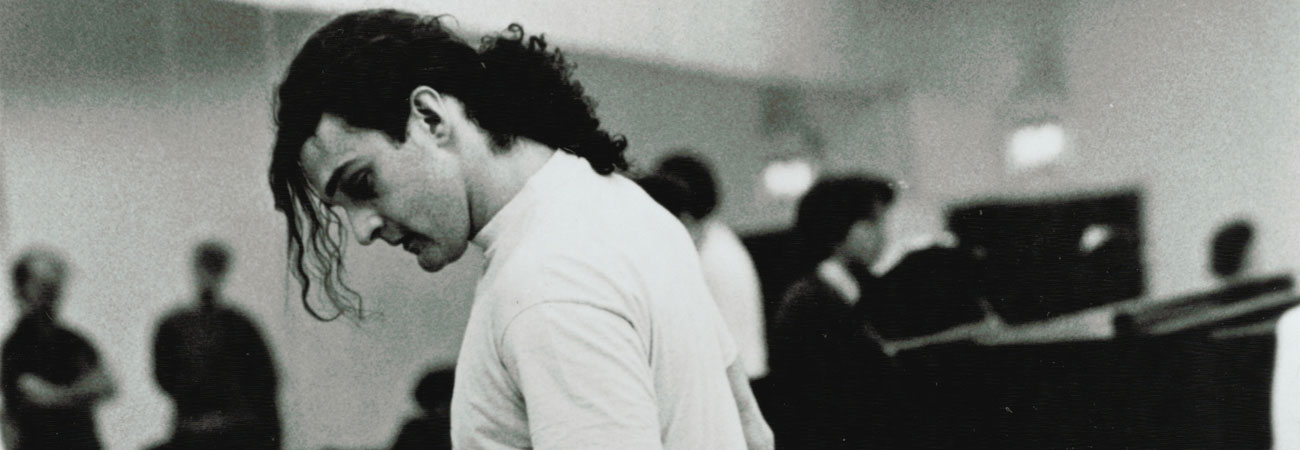
Mark Morris: Musician-Choreographer
Mark Morris: Musician-Choreographer
by Stephanie Jordan
Published by Dance Books UK
Of any choreographer working today, Mark Morris is most often cited for emphasis on musical values and standing within the music profession. His work also raises fundamental questions about how music informs our understanding of dance and about the interaction between seeing and hearing. This book is the first detailed study of Morris’s use of music, revealing an unmatched range of approaches to music and strategies for making us hear musical scores in new ways. It also has impact well beyond his work, in outlining a choreomusical framework for discussion that, for the first time, introduces ideas from cognitive science.
Divided into three parts, the book opens with a discussion of the context of Morris’s work as a musical journey across his career and in relation to earlier choreomusical theories and processes. After proposals as to how to watch and listen to dance, Morris’s output is discussed within three periods: 1980-88 (the early years of his dance group), 1988-91 (when he was resident in Brussels), and 1992-2014. The choreographer’s own voice is heard regularly throughout the book, and analyses of his dances are illustrated by the film clips below.
Order the book at the MMDG Store >
Download the Video Companion document for full listing information >
A note from Stephanie Jordan:
Welcome to the dance clips that accompany my book on Mark Morris. This is an ideal opportunity to see and hear the detail of the dances discussed in the book, all performed by members of the Mark Morris Dance Group. Please bear in mind that, unless otherwise indicated, all the clips come from company recordings of live performances, and were intended to document the choreography, not to be edited dance films as such. Occasionally, you will catch the ambient sound of the audience in a performance as well as the music.
Clips are organised primarily under chapter headings and in the order in which the dances are discussed. They are numbered accordingly, e.g. 4-1 refers to Chapter 4, clip 1. Check out too the full index of clips, in order of dance title, as sometimes a single dance is represented by clips housed under more than one chapter heading. Here, at the end of each clip title, there is a reference to the page number in the book where analysis of the choreography and its music begins.
Enjoy,
The following videos correlate to the chapters in the book:
Chapter 4
4-1, Dido and Aeneas (1989), Purcell, Dido’s Lament
4-2, All Fours (2003) Bartók, Fourth String Quartet, third movement; duet
4-3, Mozart Dances, ‘Double’ (2006), Mozart, Sonata in D for Two Pianos, first movement, second subject; ‘finger motif’
4-4, Dido and Aeneas (1989), Purcell, Dido’s aria, ‘Ah! Belinda’
4-5, Dido and Aeneas (1989), Purcell, ‘Fear no danger’
4-6, Festival Dance (2011), Hummel, Piano Trio No. 5 in E major, Rondo
4-7, Rhymes with Silver (1997), Harrison, ‘Prince Kantemir’
Chapter 5
5-1, Ten Suggestions (1981), Tcherepnin, Bagatelle No. 2; opening dance
5-2, Ten Suggestions (1981), Tcherepnin, Bagatelle No. 5; ‘chair’ dance
5-3, Fugue (1987), Mozart, Fugue in C Minor for Two Pianos (orchestrated)
5-4, Marble Halls (1985), Bach, Concerto for Violin and Oboe, third movement
5-5, Gloria (1981), Vivaldi, ‘Laudamus Te’
5-6, Gloria (1981), Vivaldi, ‘Dominie Deux, Rex coelestis’
5-7, I Love You Dearly (1981), traditional Romanian songs, first song/dance
5-8, Canonic 3/4 Studies (1982), piano pieces arr. Harriet Cavalli; opening dance
5-9, Canonic 3/4 Studies (1982), Czerny (study), No. 7
5-10, New Love Song Waltzes (1982), Brahms, Neue Liebeslieder Walzer, ‘Alles, alles in den Wind’
5-11, The Vacant Chair (1985), Rasbach, ‘Trees’
5-12, One Charming Night (1985), Purcell, ‘Hark! The Ech’ing Air’
5-13, Frisson (1985), Stravinsky, Symphonies of Wind Instruments; ending
5-14, Championship Wrestling After Roland Barthes (1984), Garfein
Chapter 6
6-1, L’Allegro, il Penseroso ed il Moderato (1988), Handel, ‘Three Graces’
6-2, L’Allegro, il Penseroso ed il Moderato (1988), Handel, ‘Sage and Holy’
6-3, L’Allegro, il Penseroso ed il Moderato (1988), Handel, ‘Haste Thee Nymph’
6-4, L’Allegro, il Penseroso ed il Moderato (1988), Handel, ‘Come, Come [but keep thy wonted state]’
6-5, L’Allegro, il Penseroso ed il Moderato (1988), Handel, Finale
Chapter 7
7-1, Dido and Aeneas (1989), Purcell, Dido’s aria, ‘Ah! Belinda’
7-2, Dido and Aeneas (1989), Purcell, ‘Banish Sorrow’
7-3, Dido and Aeneas (1989), Purcell, ‘Thanks to these lonesome vales’
7-4, Dido and Aeneas (1989), Purcell, ‘When monarchs unite’
7-5, Dido and Aeneas (1989), Purcell, ‘Fear no danger’
7-6, Dido and Aeneas (1989), Purcell, Dido’s Lament
Chapter 8
8-1, The Hard Nut (1991), Tchaikovsky, The Nutcracker, ‘Waltz of the Snowflakes’; Snow
Chapter 9
9-1, Orfeo ed Euridice (1996), Gluck, ‘Echo’ aria
9-2, Romeo and Juliet: On Motifs of Shakespeare (2008), Prokofiev, ‘Grand Flight’
Chapter 10
10-1, Four Saints in Three Acts (2000), Thomson, Prologue
10-2, Four Saints in Three Acts (2000), Thomson, Act 2
10-3, Socrates (2010), Satie, Part 3, second half, the ‘Socrates motif’
Chapter 11
11-1, Rhymes with Silver (1997), Harrison, ‘5-tone Kit’
11-2, Grand Duo (1993), Harrison, ‘Stampede’
Chapter 12
12-1, Rondo (1994), Mozart
12-2, V (2001), Schumann, Piano Quintet
12-3, V (2001), Schumann, Piano Quintet
12-4, Italian Concerto (2007), Bach, second movement
12-5, All Fours (2003), Bartók, Fourth String Quartet, first movement
12-6, All Fours (2003), Bartók, Fourth String Quartet, third movement
12-7, Empire Garden (2009), Ives, Trio, first movement, bars 1-27
12-8, Empire Garden (2009), Ives, Trio, second movement, bars 1-95
Chapter 13
13-1, Mozart Dances, ‘Eleven’ (2006), Piano Concerto No. 11, first movement
13-2, Mozart Dances, ‘Eleven’ (2006), Piano Concerto No. 11, second movement
13-3, Mozart Dances ‘Double’ (2006), Sonata for two pianos, first movement
13-4, Mozart Dances, ‘Double’ (2006), Sonata for two pianos, second movement
13-5, Mozart Dances, ‘Twenty-Seven’ (2006), Piano Concerto No. 27, first movement
13-6, Mozart Dances, ‘Twenty-Seven’ (2006), Piano Concerto No. 27, second movement
Additional Clips
A-1, Sang-Froid (2000), Chopin, Mazurka in A minor
A-2, Sang-Froid (2000), Chopin, Prelude in A major

